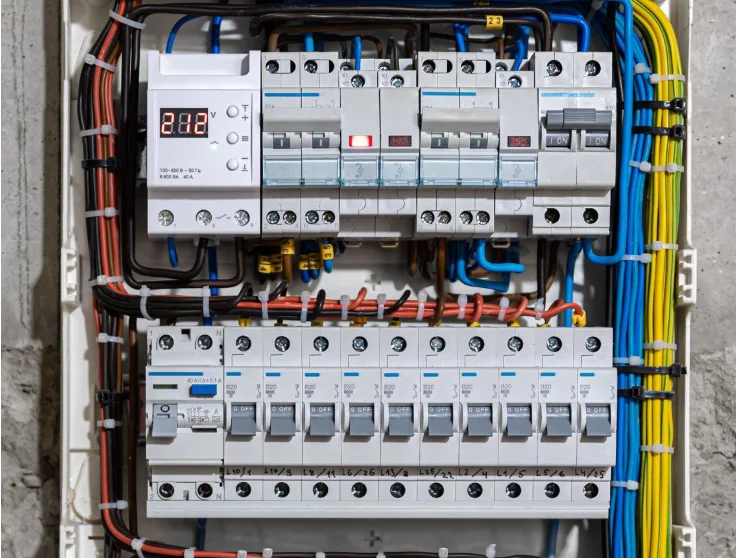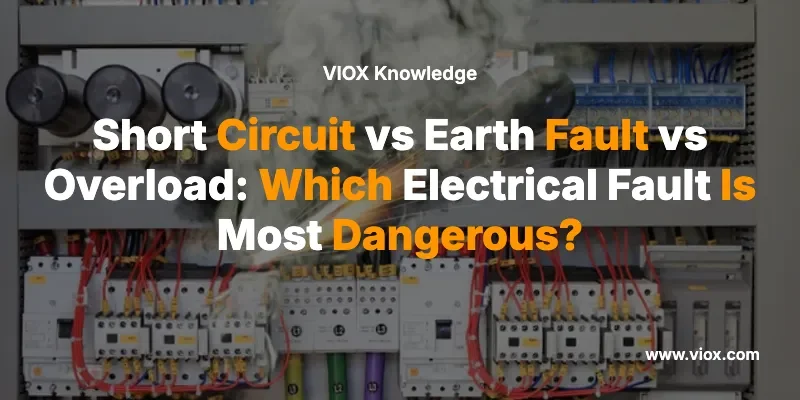電気系統の故障は毎年何千件もの火災や負傷の原因となっていますが、すべての電気系統のトラブルが同じレベルのリスクを伴うわけではありません。電気系統の安全性を気にする住宅所有者の方でも、プロの電気技師の方でも、ショート、地絡、過負荷の違いを理解することで、人命を救い、高額な損害を防ぐことができます。
この包括的なガイドでは、各タイプの電気的障害、それらの相対的な危険性、そして最も重要な点として、電気システムでそれらが発生するのを防ぐ方法について説明します。
最も一般的な3つの電気故障を理解する

ショートとは何ですか?
A ショートサーキット電流が抵抗がほとんどない、あるいは全くない状態で、通常の回路経路を迂回して意図しない経路をたどる場合に発生します。これは以下の場合に発生します。
- 通電中の電線は直接接触する 中性 ワイヤー
- 導体間の絶縁が破壊される
- 金属物体が電気接続を橋渡しする
- 配線不良により意図しない接続が生じる
即時的な効果:
地絡故障とは何ですか?
アン地絡 (地絡とも呼ばれます)は、電流が通電導体から中性導体を通って戻らずに、大地または接地システムに流れ込むことで発生します。一般的な原因には以下が含まれます。
- 絶縁材が損傷し、電流が金属ケースに到達する
- 電気機器への水分の浸入
- 接地面に触れる劣化した配線
- 断熱性が損なわれた不良家電
即時的な効果:
- 接地への電流漏れ
- 感電の恐れ
- RCD/GFCI 保護は通常起動します
- 機器の故障
- 乾燥した条件での火災の危険性
オーバーロードとは何ですか?
アン 過負荷 電気回路が安全に扱える電流を超える電流を流した場合に発生します。これは通常、以下の原因で発生します。
- 1つの回路に接続されているデバイスが多すぎる
- 予想以上に電力を消費する家電製品
- 電気負荷に対する配線のサイズが小さすぎる
- 徐々に劣化し、回路容量が減少
即時的な効果:
- 導体内の過度の熱蓄積
- 経年劣化による断熱材の劣化
- 回路ブレーカーのトリップ(遅延する場合があります)
- 機器寿命の低下
- 過熱した部品による火災の危険性

比較分析: どの断層が最も危険か?
| 障害の種類 | 発症のスピード | 現在の大きさ | 火災の危険性 | ショックリスク | 検出の難しさ |
|---|---|---|---|---|---|
| ショートサーキット | 瞬時 | 非常に高い | 非常に高い | 中程度 | 簡単(即時) |
| 地絡 | 変数 | 低~中程度 | 中程度 | 非常に高い | 中程度 |
| オーバーロード | 徐々に | やや高い | 高 | 低 | 困難(徐々に) |
ショート:最も直接的な破壊
ショートが危険リストのトップに挙げられる理由:
ショートは 最も高い即時リスク 爆発性があり、大きな電流サージが発生する可能性があるためです。短絡が発生すると、次のような事態が発生します。
- 電流は1000%以上増加する可能性がある 数ミリ秒以内
- 気温は3000°Fを超えることがある 断層点において
- アークフラッシュは重度の火傷を引き起こす可能性がある 近くにいる人
- 機器の破壊は瞬時に起こることが多い そして完了
ただし、現代の電気システムは、高速動作の回路ブレーカーとヒューズを備えており、通常 1 ~ 3 サイクル (0.02 ~ 0.05 秒) 以内に障害を解消し、短絡に対処できます。
アース・フォルト:サイレント・キラー
地絡が意外と危険な理由:
地絡はそれほど深刻ではないように思えるかもしれませんが、次のような特有のリスクを伴います。
- 感電の危険性が最も高い 電流が意図しない経路を流れるため
- 検出されずに存続する可能性がある 長期間にわたって
- 標準の回路ブレーカーが作動しない場合があります 電流が過剰でない場合
- 継続的な火災リスクを生み出す 可燃性環境において
地絡は、人が触れる可能性のある金属表面に電流を流し、致命的な感電の危険を引き起こす可能性があるため、特に危険です。
オーバーロード:スローバーンの脅威
オーバーロードを過小評価してはいけない理由:
過負荷は主に 陰険な性質:
- 熱は徐々に高まります検出が困難になる
- 断熱材はゆっくりと劣化する時間の経過とともにシステムの安全性が低下する
- 即時保護が発動されない可能性があるダメージが蓄積される
- 条件を作り出す ショートや地絡につながる可能性がある
現実世界のシナリオとケーススタディ
住宅の短絡事故
場合: 住宅所有者が天井ファンを設置しようとした結果、配線が逆接続され、活線と中性線の間で直接ショートが発生しました。
結果: について 20アンペアブレーカー すぐにトリップし、火災は防がれました。しかし、電気ボックスには軽度の熱損傷が発生し、保護装置が適切に機能していなかった場合、配線ミスにより重傷を負う可能性がありました。
重要な教訓: たとえ「軽微な」電気工事であっても、適切な知識と安全プロトコルの遵守が必要です。
商業用地絡緊急時
場合: レストランの食品調理エリアで、損傷した延長コードが金属製のシンクを介して地面への経路を作ったため、接地故障が発生しました。
結果: 故障発生中に従業員がシンクに触れ、重度の感電を受けました。古い建物にはGFCI保護装置が設置されていなかったため、危険な状態が続いていました。
重要な教訓: 水と電気が共存する地域では、接地故障保護 (GFCI/RCD) が重要です。
産業過負荷シナリオ
場合: ある製造施設では、電気インフラをアップグレードすることなく、数年にわたって既存の回路に徐々に機器を追加してきました。
結果: 慢性的な過負荷により絶縁不良が発生し、複数の機器が故障して 3 日間の生産停止に至りました。
重要な教訓: 時間の経過とともに負荷が増加するため、電気システムを評価し、アップグレードする必要があります。
各障害タイプに対する予防戦略
短絡防止
インストールのベストプラクティス:
- すべての接続に適切なワイヤーナットと接続ボックスを使用してください
- 導体間の適切な間隔を維持する
- 環境条件に適した断熱定格を採用する
- 端子接続についてはメーカーのトルク仕様に従ってください
メンテナンスの必要性:
- 電気パネルと接続箱の定期点検
- 緩んだ接続を示すホットスポットを検出する熱画像
- 老朽化した部品を故障前に交換する
- 5~10年ごとの専門的な電気監査
地絡事故防止
必須の保護対策:
- 必要なすべての場所にGFCI/RCD保護を設置する
- 漏電保護装置の定期検査(毎月)
- すべての電気機器およびシステムの適切な接地
- 損傷したコードと機器の絶縁材の即時修理
環境への配慮:
- 電気エリアの湿気管理
- 屋外電気接続部の適切な密閉
- 過酷な環境に適したIP定格機器の使用
- 埋設ケーブルシステムの定期検査
過負荷防止
システム設計の原則:
- 初期設置時の適切な負荷計算
- 予想される成長に対応できる十分な回路容量
- 予想される負荷に適したワイヤサイズの使用
- 適切な定格の保護装置の設置
継続的な管理:
- 回路負荷の定期的な監視
- 利用可能な回線間の負荷分散
- ニーズの増大に応じて電気システムをタイムリーにアップグレード
- 電気容量制限に関するユーザー教育
最新の保護技術
回路ブレーカーとヒューズ
標準保護:
- 熱磁気ブレーカー 過負荷と短絡の両方に対応する
- 電子ブレーカー 正確なトリップカーブと高度な機能を提供する
- アーク故障回路遮断器(AFCI) 危険なアーク放電状態を検出する
- AFCI/GFCIの組み合わせ デバイスは包括的な保護を提供します
高度な監視システム
スマート電気パネル:
- すべての回路のリアルタイム電流監視
- 異常な電気活動に対する自動アラート
- 予測保守のための履歴データ分析
- 商用アプリケーション向けのリモート監視機能
電力品質アナライザー:
- 電圧、電流、力率の連続監視
- 問題が発生する前に電気障害を検出する
- ビル管理システムとの統合
- 保守計画のための自動レポート
電気工事のプロ vs. DIY
プロを呼ぶタイミング
必ず専門家による設置が必要です:
- サービスパネルのアップグレードまたは変更
- 新しいサーキットの設置
- 電気システムのトラブルシューティング
- コードコンプライアンス検査
- 産業用または商業用の電気工事
安全なDIY電気工事
住宅所有者が行う適切な作業:
- コンセントとスイッチの交換(電源オフ)
- 基本的な照明器具の設置
- 既存のコンセントに家電製品を接続する
- 基本的な電気メンテナンスと清掃
必須の安全ルール:
- 必ずブレーカーで電源を切ってください
- 非接触電圧テスターで回路をテストする
- 適切な個人用保護具を使用する
- 嵐の間は電気系統の作業をしないでください
- 疑問がある場合は専門家に相談してください
よくある質問
住宅火災で最も多く発生する電気系統の故障は何ですか?
過負荷と短絡 電気火災の大部分は、電気系統の故障が原因です。全米防火協会によると、電気系統の故障は年間推定1億3千万件の住宅火災を引き起こしており、過負荷の回路とショートが主な原因となっています。
落ち続けるブレーカーをリセットできますか?
落ちたブレーカーを繰り返しリセットしないでください 根本的な問題を特定し、解決せずに放置すると、ブレーカーが複数回落ちる場合、深刻な電気系統の故障が発生している可能性があり、専門家の診断が必要です。ブレーカーのリセットを繰り返すと、火災や機器の損傷につながる可能性があります。
電気システムはどのくらいの頻度で検査する必要がありますか?
住宅用システム 10年ごと、または住宅を購入する際に専門家による検査を受ける必要があります。 商業および産業システム 毎年の検査を義務付け、重要なシステムは四半期ごとに検査します。
ショートと地絡の違いは何ですか?
A ショートサーキット 活線と中性線の間を最小限の抵抗で電流が流れるのに対し、 地絡 通電中の導体から接地へ電流が流れることで発生します。短絡は通常、即座に深刻な故障を引き起こしますが、地絡は検知されずに持続し、継続的な感電の危険を引き起こす可能性があります。
過負荷で必ず回路ブレーカーが落ちないのはなぜですか?
サーキットブレーカーは 熱素子 過電流状態による発熱に反応するブレーカーです。過負荷がブレーカーの定格をわずかに上回る場合、サーマルエレメントを作動させるのに十分な熱が発生するまで数分、あるいは数時間かかることがあります。この遅延反応により、保護が作動する前に、慢性的な過負荷によって配線が損傷する可能性があります。
GFCI コンセントは地絡に対して十分な保護力がありますか?
GFCIコンセントは優れた保護を提供します 直近の接地故障に対しては保護しますが、回路全体を保護するわけではありません。包括的な接地故障保護のためには、 家全体のGFCIブレーカー または 残留電流装置(RCD) 回路全体の接地故障状態を監視します。
電気システムが過負荷になっているかどうかはどうすればわかりますか?
電気過負荷の警告サインには次のものがあります:
- 家電製品の起動時に照明を暗くする
- 暖かいコンセントプレートまたはスイッチカバー
- 電気部分からの焦げ臭い臭い
- 頻繁にブレーカーが落ちる
- ちらついたりブーンという音を立てたりする光
- 電化製品による軽度の感電
緊急対応手順
電気緊急事態への即時対応
電気に関する緊急事態の場合:
- 電源を切る 安全であればメインブレーカーで
- 緊急サービスに電話する 火災や怪我が発生した場合
- 決して触れないでください 感電する人がいるかもしれないので、まず電源を切ってください。
- クラスC消火器を使用する 電気火災用
- 地域から避難する 焦げた臭いがしたり煙が見えたりしたら
緊急事態後の手順
差し迫った危険が去った後:
- 事故を写真で記録する(安全であれば)
- システム評価については資格のある電気技師にご相談ください
- 重大な事故を保険会社に報告する
- 電気安全手順の見直しと改善
- 再発防止のため保護システムのアップグレードを検討
結論:電気安全を最優先する
それぞれの種類の電気故障は独自の危険性を伴いますが、 短絡は最も大きな即時リスクをもたらす 爆発性があり、瞬間的な損傷を引き起こす可能性があるためです。しかし、過負荷の潜行性や地絡による持続的な感電の危険性により、これら3種類の故障タイプはいずれも深刻な安全上の懸念事項となっています。
電気安全に対する最も効果的なアプローチは次のとおりです。
- 包括的な保護システム 最新の回路ブレーカー、GFCIデバイス、サージ保護装置など
- 定期的な専門家による検査 潜在的な問題が危険になる前に特定する
- 適切な電気工事 適切な回路容量と高品質の設置技術を含む
- ユーザー教育 電気安全と警告標識の認識について
重要な収穫 よりもさらなる断層は"悪しきにつけ、"投資が堅調に推移し、電気的保護システムを維持する電気的インフラを適切にし、適切な専門家のための重要な電気的ます。 この包括的なアプローチを保護すべての種類の電気が発生します。
電気安全とは、単に法令を遵守することだけではありません。電気システムの適切な設計、設置、そしてメンテナンスを通して、人命と財産を守ることでもあります。ご不明な点がある場合は、必ず資格を持った電気専門家にご相談ください。専門家は、お客様の状況を的確に評価し、適切な安全対策をご提案いたします。
電気の安全性を向上させる準備はできていますか? まず専門家による電気検査を実施して、システム内の潜在的な危険性を特定し、次に現在の安全基準と特定の電気ニーズに基づいて適切なアップグレードを実装します。
関連
住宅用電気パネルで最も一般的なブレーカーのサイズは何ですか?
IEC 60898-1 vs IEC 60947-2: 電気回路遮断器規格の完全ガイド


